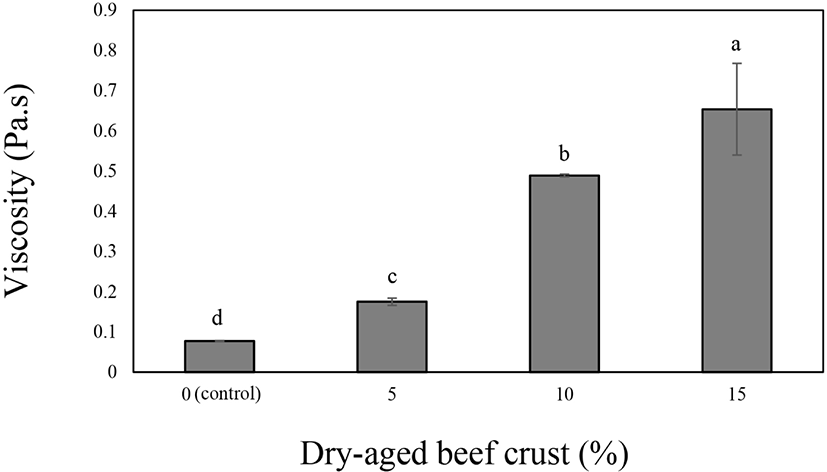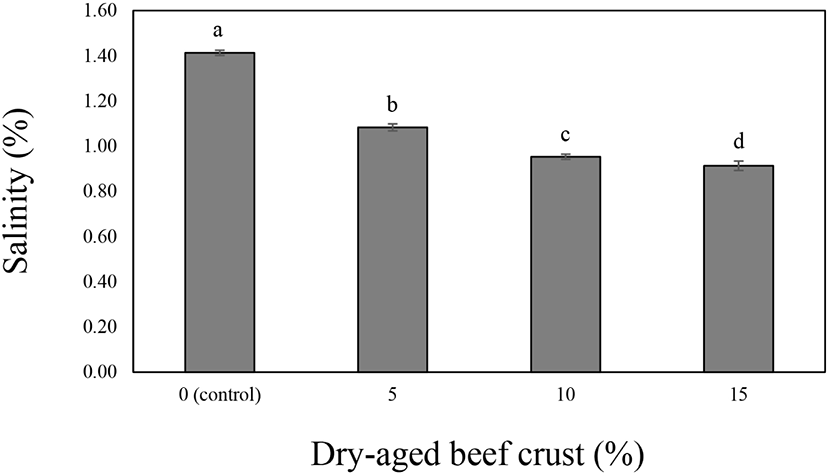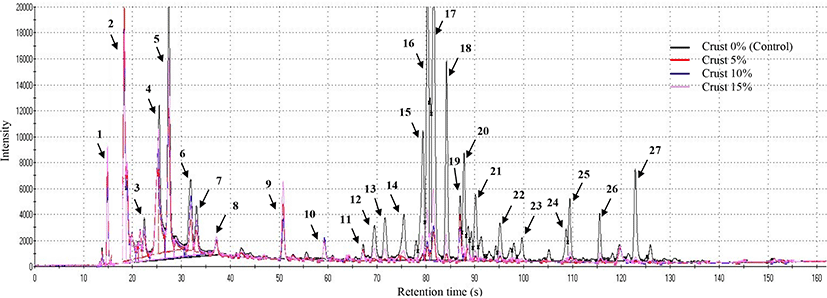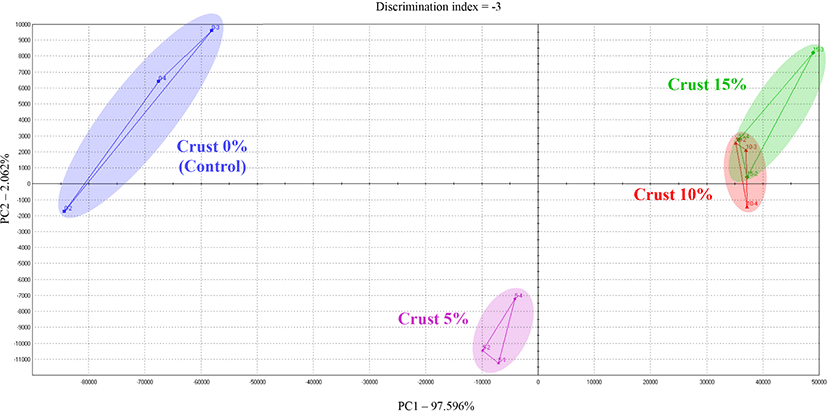Introduction
The global sauce market revenue saw a 46.98% increase from 2010 to 2019, from $86,898 million to $127,731 million, and is forecasted to continue growing (Statista, 2019). Sauce as a flavor-enhancer, along with color, and are complex seasoning mixtures with varying ingredients (Mcgee, 2004). Flavor is an important factor for sauce palatability—a sauce must satisfy gustatory and olfactory senses. Commonly used natural flavor-enhancers for sauce include vegetables (e.g., green onions, onions, garlic, pepper, and ginger) and seafoods (e.g., anchovies, shrimp, clams, and crevices) (Methven, 2012). As a sauce flavor-enhancer, meat extracts is typically used in meat stocks and gravy products in some countries. Thus, meat-derived products are restricted to their utilization as spice and in sauce preparation (Varavinit et al., 2000). Among various sauces, brown sauce is world-wide to flavor a diverse range of foods (Mcgee, 2004). Depending on the additional ingredient and the manufacturer, there are various products (William and Akiko, 2012). In particular, many types of brown sauces (e.g., Bigarade sauce, Bordelaise sauce, Devilled sauce, and Lyonnaise sauce, etc.) are used in meat and meat products.
Recently, consumers have shown a preference for quality to quantity during food purchase; hence, high-quality differentiated dry-aged beef has gained consumer attention (Boleman et al., 1997). Unlike wet aging, where the meat is packaged, dry aging partially exposes the meat to air. As moisture in the meat evaporates during the dry aging process, the flavor becomes concentrated and enriched (Lee et al., 2019). Due to this unique flavor, the dry-aged meat is favored by many; nevertheless, the dry aging process also causes surface hardening, which forms a crust on the meat (Laster et al., 2008; Ryu et al., 2018).
Dry-aged beef have been consumed for premium steaks mostly in fine restaurants and upscale grocery stores, but, expanding dry-aged beef consumption market such as common grocery stores (supermarket) and butcher shop (Stenström et al., 2014). As such, the dry-aged beef demand for consumers is increasing due to the unique flavor and taste of dry-aged beef, but as the consumption of dry-aged beef increases, the amount of crust is also increasing. In addition, crust is non-edible but it constitutes 15%–35% can increase the dry-aged beef price (Dashdorj et al., 2016). Therefore, it must be devised to various utilization methods for crust so that the dry-aged beef price stabilization and expansion of consumption. However, the crust has abundant dry-aging flavor compounds because it is trimmed from dehydrated meat surfaces. Hence, the crust could be utilized as a flavor-enhancer. Furthermore, as the crust has exhibited beneficial antioxidant and antihypertensive activities, it has been previously used as a natural flavor-enhancer in beef patties (Park et al., 2018). Nevertheless, crust utilization in sauce preparation has not been widely investigated; therefore, the use non-edible parts of dry-aged beef byproducts, e.g., crust, as a flavor-enhancer in sauces must be researched.
To investigate if crust, the by-product from dry aging meat, can potentially be used in the food industry, it was added to brown sauce and the physicochemical and organoleptic properties were examined.
Materials and Methods
In total, six pieces of beef loin (M. longissimus dorsi) were obtained from six carcasses (Holstein steer; Korea quality grade 3) that were two days postmortem, and were divided into three sections of equal length and width. These sections of beef loin were then dry-aged in a dry-aging fridge (DA-45, Korea alesso, Gyeonggi-do, Korea) for four weeks (temperature, 4°C; air velocity, 5±3 m/s; humidity, 80±5%). The crust was cut (height 0.3–0.7 cm) from the outermost edge of the dry-aged beef loin, and was subsequently freeze-dried (FDU-1110, Eyela, Tokyo, Japan) at –70°C for 15 h.
A basic brown sauce was used in this study and was manufactured according to the methods of Lee et al. (2007); and the ingredients are presented in Table 1. Initially, water, hot pepper paste, and tomato paste were mixed for 5 min at 70°C to prepare the brown sauce solution. Secondly, starch dissolved in water was added and the solution was stirred for 4 min at 95°C. After gelatinization, sugar, soy sauce, Worcestershire sauce, garlic, onion, and mirin were added to the solution and it was mixed for 10 min at a constant temperature of 95°C. Lastly, starch syrup, vinegar, basil powder, oregano powder, and bay-leaf powder were added to the solution and mixed for 5 min at 95°C. Following manufacturing, the samples of this basic brown sauce had 0% (control), 5%, 10%, and 15% crust added and were each mixed for 5 min at a temperature maintained at 95°C. The samples were cooled at 20°C for 30 min and then stored at 4°C while the experiments were being conducted. Physicochemical properties (proximate composition, pH, color, and swelling yield) of the crust are presented in Supplementary Table S1.
The proximate composition was measured using methods that comply to the AOAC (1990). The moisture, crude protein, crude fat, and ash contents were measured by oven-drying, Kieldahl, Soxhlet, and dry-ashing methods, respectively.
The CIE general color, lightness (L*), redness (a*), and yellowness (b*) were measured using a colorimeter (CR-10, Minolta, Tokyo, Japan). A white standard plate (CIE L*, +97.83; CIE a*, –0.43; CIE b*, +1.98) was used for reference.
Homogenized samples were prepared from 4 g of each sample and 16 mL of distilled water, using an Ultra-Turrax homogenizer (HMZ-20DN, Poolim Tech, Seoul, Korea) at 10,923×g for 1 min. The pH was then measured using a pH meter (Model S220, Mettler-Toledo, Schwerzenbach, Switzerland).
Each sample (10 g) was mixed with 100 mL of pH 3, pH 4 Tris-HCl buffer, and distilled water, respectively and stirred using a vortex mixer (SVM-10, SciLab, Seoul, Korea) for 1 min. The samples were then left at room temperature (25°C) for 1 hr. The supernatant was removed and the remaining sediment was weighed. The percentage swelling yield was calculated from the sediment weight using the equation below.
The viscosity of the samples was measured using a rotational viscometer (Merlin VR, Rheosys, Hamilton Township, NJ, USA). The viscometer was attached to a 30-mm cone, and the sample was placed in a 25-mm co-axial cylinder. Measurements were performed over 60 s at 25°C with a head speed of 0.43×g. The average of the measured values was calculated and presented in units of Pa.s.
For measuring brown sauces salinity measurements were taken using a salinity meter (SB-2000PRO, HM Digital, Redondo Beach, CA, USA), measured values were presented a salinity (%).
Aroma profiling of the brown sauce samples was performed using a Heracles II electronic nose (Alpha MOS, Toulouse, France). The electronic nose analysis conditions were as follows: Injected volume, 5 mL; injection temperature, 200°C; Trap ready temperature, 40°C; sampling duration, 4 s; trap desorption temperature, 250°C; injection duration, 1.5 s; column temperature program, 51°C (10 s) to 260°C (4 s); detector temperature, 260°C. Before the PCA, the sensitivity of each electronic-nose sensor was measured to determine the rate of change between the resistance values of the volatile compound and the air. These measured sensitivity values were used in the Alpha soft program (Alpha MOS) employed for the PCA procedure. The classified aroma pattern was given as the primary component value (PC1) and the secondary component value (PC2).
The sensory evaluations of each sample were performed in triplicate by 10 sensory panelists. The panelists used basic taste identification tests and trained with commercial brown sauce products for 7 days (1 hr sessions per day) to familiarize themselves with the sensory properties to be evaluated. The color, taste, flavor, viscosity, and overall acceptability (1, extremely undesirable; 10, extremely desirable) of the samples were evaluated on a 10-point descriptive scale. The sensory evaluation was approved by the Kongju National University’s Ethics Committee (Authority No: KNU 2020-15).
The results for all the analyses, except the electric nose, were assessed after a minimum of 3 trials. Statistical analysis of variance was performed on all variables, compiled, and analyzed by the general linear model (AVOVA), using SAS version 9.3 (SAS Institute, Cary, NC, USA), and Duncan’s multiple range test, which verified the significance of the differences (p<0.05). The gathered data were presented as mean±SD.
Results and Discussion
The general composition of brown sauces with varying levels of dry-aged beef crust are provided in Table 2. Excluding ash content, we observed significant differences in the contents of moisture, fat, and protein. As more crust content was introduced, the moisture level of the samples exhibited an overall decrease, while the fat and protein contents both increased (p<0.05). In a comparable case, it was reported that the general composition of sauce or gravy products changed depending on the compositions of the ingredients being added in or taken out (Abdullah et al., 2018; Tsikritzi et al., 2015). Likewise, in this study, the differences seen in the general composition of the sauce samples were believed to be caused by the high content of fat and protein in the crust (fat: 29.81%, protein: 56.25%; Supplementary Table S1).
Sauces are semi-solid foods (Juszczak et al., 2004), and their color tends to change with different additives. As the sauce color greatly affects the consumer selection of the product, the effect of the crust additive on the brown sauce color was studied (Table 3). The lightness (CIE L*) and yellowness (CIE b*) of the samples were significantly augmented with the addition of crust content (p<0.05). Similarly, the redness (CIE a*) of the samples intensified with increasing crust content. These changes in the sample chromaticity are likely influenced by the chromaticity of the crust (L*, 45.00; a*, 8.50; b*, 7.30; Supplementary Table S1). Although, the CIE b* values of the samples containing the crust additive (7.92–9.32) were higher than that of the crust alone (7.30, Supplementary Table S1). When beef is heated above a certain temperature it browns, which increases the yellowness (Young and West, 2001). With the addition of the crust, the browning is believed to have occurred at 95°C during the process of heating.
The pH values of brown sauces with different crust contents are provided in Table 3. The pH values of the samples increased when adding a crust content of up to 10% (p<0.05); however, insignificant differences were observed when the added crust was above 10%. Despite the pH not changing when >10% crust was added, the pH variations observed with lower levels of added crust seemed to be influenced by the pH of the crust (5.27, Supplementary Table S1). Similar cases have shown variations in the pH of gravy and brown sauce due to additives (Juneja et al., 1999; Lee et al., 2007); thus, supporting the link observed between the pH changes of brown sauce with the addition of crust.
The high viscosity of sauces serves as an indicator of how well the additives are mixed (Yapar et al., 2006). To control the viscosity, using emulsion agents like that the starch and whey protein are commonly used (Kadam et al., 2018). When the viscosity is excessively low the sauce will likely flow off of the food; whereas, excessively high viscosity will restrict the usage of the sauce (Zeng et al., 1996). The viscosity of the control sample was shown to be 0.07 Pa.s, which increased to 0.17 Pa.s, 0.48 Pa.s, and 0.65 Pa.s, for 5%, 10%, and 15% crust addition, respectively (Fig. 1; p<0.05). This shows that the lyophilized crust had a swelling yield of 278.94% at a pH of 4, which was higher than the other conditions (Supplementary Table S1). The high swelling power of crust additive in brown sauce, which has a pH range around of 4–5, contributed to the binding of the ingredients composing the sauce. The swelling potential of the crust, according to the powdering of the raw materials, is said to be greater when it is freeze-dried, rather than heat-dried. Furthermore, the lyophilized products are known for their rehydration ability (Eshtiaghi et al., 1994). The crust used in the present study underwent freeze-drying; therefore, it can be deduced that the addition of this crust led to rehydration and enhanced the mixing potential of the additives in the brown sauce.

The salinity of brown sauce with different crust contents is shown in Fig. 2, which decreased from 1.41% to 0.91% as the crust content increased (p<0.05). This can be explained by the decreasing proportion of added raw materials, due to increasing crust additive, that affect the salinity of the sauce, such as red pepper paste, soy sauce, and Worcester sauce. Similarly, Kim et al. (2009) observed a salinity reduction during the processing of demi-glace sauces when thickening agents, such as roux, were added. Nowadays, consumer health is at risk of developing various diseases related to excessive sodium consumption. Considering this, the meat industry is developing various low-sodium meat products with the goal of reducing the sodium intake of meat consumers (Desmond, 2006). Therefore, it is advantageous that, along with enhanced umami, the addition of crust to the brown sauce also reduces the sodium content.

To examine the differences in the volatile aroma of brown sauce samples, the results of analysis of volitile compounds according to the retention time for each samples were shown in chromatograms (Fig. 3). It was confirmed that there was a change in the type and amount of volatile compounds depending on the amount of crust added. Especially, increased the nonan-2-one component, having the “baked”, “hot milk-like”, and “fatty” flavors, which are postive factors for the brown sauce flavor. This component was detected in all the samples with crust, and increased as the amount of crust added. The principal component in PC2 (2.062%) was lower than that in PC1 (97.596%). Compared to the principal component of PC1, the principal component of PC2 did not show significant difference in the aroma profiles. Thus, the aromatic components in PC1 (X-axis) were considerably different than those in PC2 (Y-axis) (Xiao et al., 2014). The PCA results for brown sauce formulated with different levels of dry-aged beef crust are shown in Fig. 4. The aromatic profiles of the control and the samples with 5% and 10% crust additive were all distinguishable from each other; however, the samples with 10%–15% crust content exhibited a close proximity of their aromatic profiles. Therefore, a crust addition of over 10% is not expected to yield significant results regarding flavor. Moreover, using PCA, Oh (2018) reported a significant difference in the flavor component between meat samples that underwent 28 days of the dry aging process and those that underwent a shorter dry aging duration. Likewise, the crust used in the present study was prepared from the dry aged beef for 28days, dry-aged meat, which likely influenced the flavor of the resulting brown sauce samples. Dry-aging process of meat results in protein decomposition due to myofibrillar fragmentation (Spanier et al., 1997), and this leads to an increase in IMP and glutamic acid content that are responsible for the umami taste (Iida et al., 2016). Hence, because the crust of dry-aged meat is concentrated with components that give an umami taste, it could influence the flavor of the brown sauce.


Table 4 consists of sensory evaluation data with respect to the various crust contents in the brown sauce samples. Differences in color were negligible between the samples, but the taste of the control sample was significantly inferior to that of the samples formulated with the crust (p<0.05). However, the differences in taste between each crust-formulated sample were not large, and the flavor overall seemed to only enhance from 0 to 10% crust addition. Furthermore, sensory viscosity of the 10% crust sample was noticeably superior than the control sample (p<0.05); whereas, minimal differences were observed between the samples formulated with the crust. The overall acceptability of samples significantly increased as crust content increased, but only up to 10% addition (p<0.05). The differences in the sensory evaluation of the taste and flavor of the samples are due to the varying crust concentrations, as flavor substances are generated in the crust during heating. During this heating process, Maillard reactions take place between carbohydrate-containing free amino groups and amino acids, and the by-product of subsequent unsaturated fat breakdown is responsible for the meaty flavor (Aaslyng and Meinert, 2017). This meaty flavor from crust, due to the drying process, is thought to have a positive impact on the characteristics of sauces, as the viscosity increases with greater crust addition (Fig. 1). Furthermore, additives with carbohydrates and proteins generally act as emulsifiers for various types of sauces (Sikora et al., 2008). Therefore, the intensified emulsification from the addition of crust was a contributing factor to the increased viscosity and enhanced sensory characteristics of the brown sauce.
Conclusion
In this study, we used a crust derived from dry-aged beef loin as a flavor enhancer for brown sauce. With increasing crust content, lightness, yellowness, and viscosity increased and salinity decreased, indicating the positive effect of crust addition. In case of redness, pH, and aromatic profile, there were no significant differences between the 10% crust and 15% crust samples. The sensory evaluation of the 10% crust sample was excellent compared to the other samples. Therefore, these results suggest that adding 10% dry-aged beef crust to brown sauces as a natural flavor enhancer can improve their physiochemical and sensory properties.













